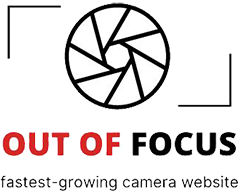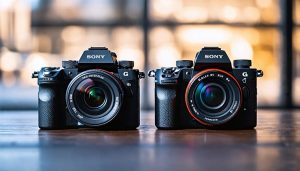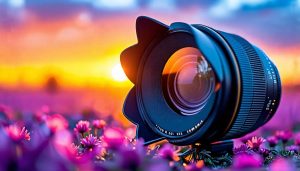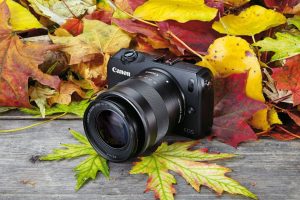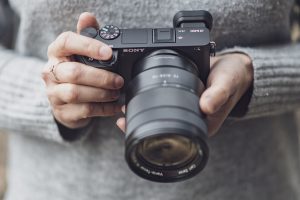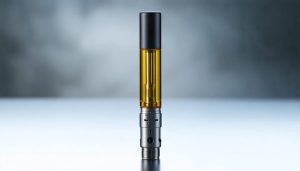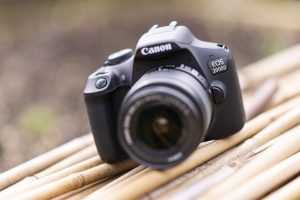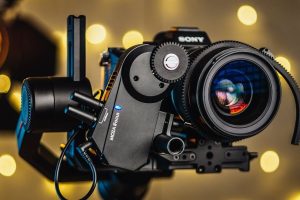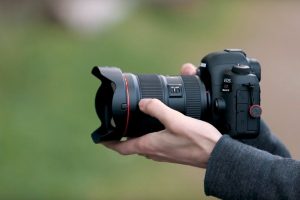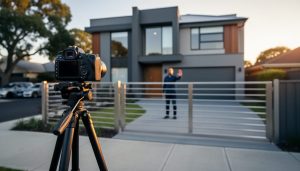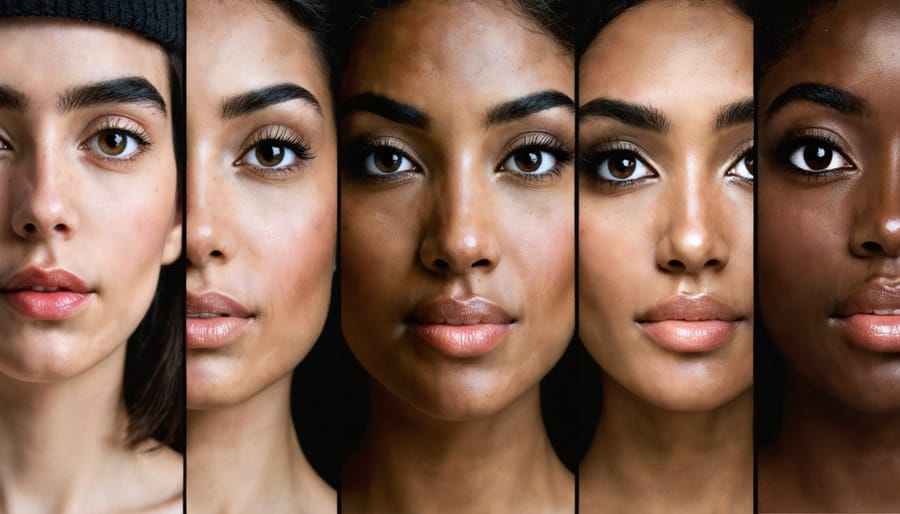
The way focal length affects composition dramatically influences how your subject’s face appears in portraits. Shoot at 85-105mm to capture naturally proportioned facial features with pleasant compression, avoiding the distortion common in wider focal lengths. Step back to 135mm for striking headshots that slim facial features and create beautiful background blur, perfect for professional portraits. Move closer with a 50mm lens to maintain natural perspective while including environmental context, ideal for lifestyle portraits and candid shots. Understanding focal length’s impact on facial features transforms ordinary portraits into compelling character studies – from the subtle nose elongation at 35mm to the flattering compression at telephoto ranges. Master this interplay between focal length and facial features to consistently capture your subjects at their most authentic and appealing.
The Science Behind Focal Length and Face Distortion
What is Perspective Distortion?
Perspective distortion in photography occurs when the distance between the camera and the subject affects how dimensional relationships appear in the final image. Unlike optical distortion, which is caused by lens design and can be fixed in post-processing when you correct lens distortion, perspective distortion is a natural phenomenon related to the physical distance between you and your subject.
Think of it this way: when you stand very close to someone, their nose appears larger relative to their ears because it’s closer to the camera. Step back several feet, and facial features appear more naturally proportioned. This effect isn’t actually caused by the focal length itself, but rather by the camera-to-subject distance required to maintain the same framing with different focal lengths.
When shooting portraits, this understanding becomes crucial. A shorter camera-to-subject distance (typically used with wide-angle lenses) will emphasize features closer to the camera and make distant features appear smaller. Conversely, shooting from further away (usually with longer focal lengths) creates a more flattering compression effect that many portrait photographers prefer for its natural-looking results.
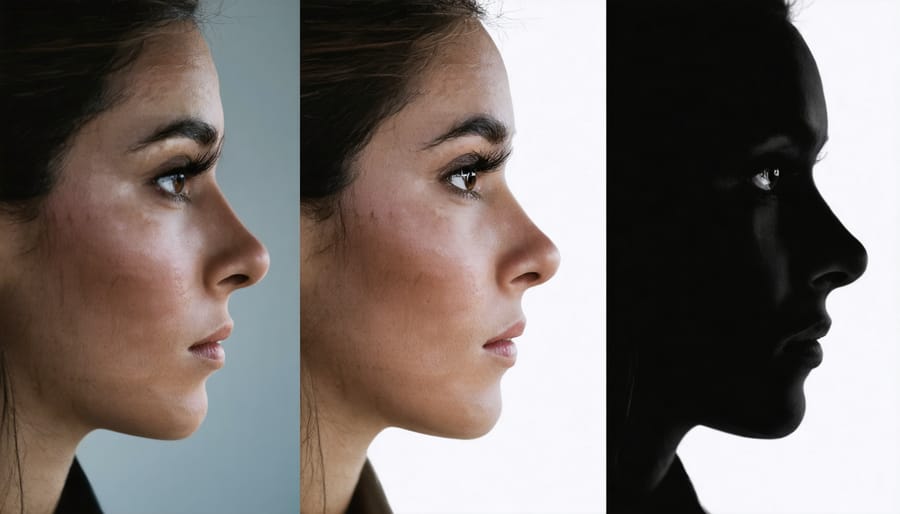
Working Distance vs. Focal Length
The relationship between working distance and focal length is crucial in understanding how facial features appear in portraits. When you change your focal length, you’ll need to adjust your distance from the subject to maintain the same framing, and this distance-to-focal-length relationship significantly impacts how facial features are rendered.
With shorter focal lengths (like 35mm), you’ll need to get closer to your subject to fill the frame, which can lead to perspective distortion – making features closer to the camera appear larger while receding others. This is why shooting portraits too close with wide-angle lenses can result in enlarged noses and seemingly smaller ears.
Conversely, longer focal lengths (85mm and above) require you to step back, creating a more compressed perspective that many consider more flattering for portraits. This compression effect makes facial features appear more proportional and natural, which is why many portrait photographers prefer focal lengths between 85mm and 135mm.
Remember that it’s not the focal length itself that causes distortion, but rather the shooting distance. The focal length simply determines how much you need to move to achieve your desired composition.
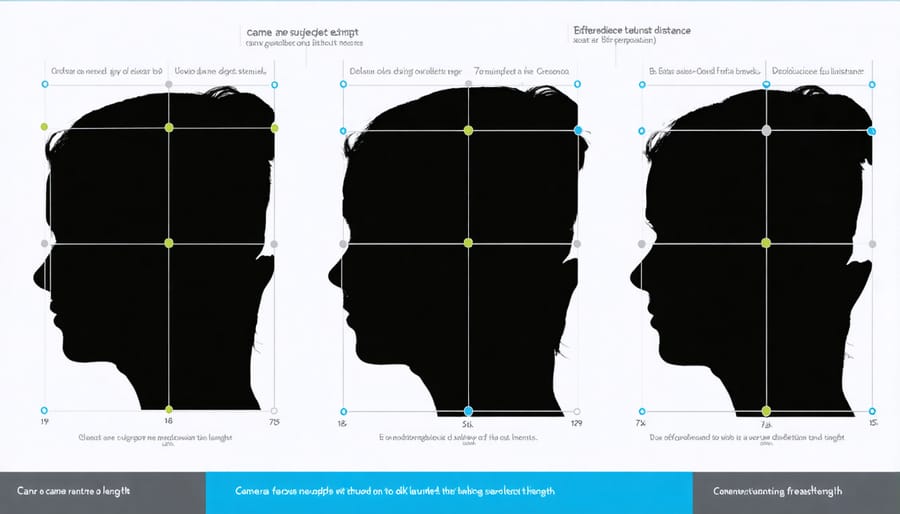
Common Focal Lengths and Their Effect on Faces
Wide-Angle (24-35mm)
Wide-angle lenses in portrait photography create distinctive effects that can be both challenging and creatively rewarding. When shooting portraits at 24-35mm, you’ll notice significant perspective distortion, particularly when positioning your subject close to the camera. Facial features near the lens appear larger and more pronounced, while those farther away seem smaller and more recessed.
This distortion can make noses appear more prominent and faces wider, especially at the edges of the frame. While this effect might not be ideal for traditional headshots, it can be leveraged creatively for environmental portraits where you want to showcase both your subject and their surroundings. Fashion photographers often use these focal lengths to create dramatic, editorial-style images with a contemporary edge.
To minimize unflattering distortion while using wide-angle lenses, keep your subject centered in the frame and maintain some distance between the camera and their face. This approach works particularly well for full-body shots or when capturing people within architectural spaces, allowing you to include context while managing distortion effects.
Remember that wide-angle portraits often convey a sense of intimacy and immediacy, making them excellent choices for documentary-style photography or when telling broader visual stories about your subject’s environment.
Standard (50mm)
The 50mm focal length is often called the “normal lens” because it closely matches the natural perspective of human vision. When shooting portraits at 50mm, you’ll capture facial features in proportions that appear most true-to-life, which is why it’s a go-to choice for many portrait photographers.
At this focal length, facial features maintain their natural relationships without significant distortion. The nose doesn’t appear unnecessarily prominent, and the distance between facial features looks natural and balanced. This creates portraits that feel authentic and familiar to viewers, as they’re seeing faces the way they’re accustomed to in real life.
Working with a 50mm lens also encourages an ideal shooting distance – typically about 4-6 feet from your subject. This distance helps create comfortable interaction between photographer and subject while maintaining natural facial proportions. The resulting images show depth and dimensionality without exaggeration, making it particularly flattering for headshots and environmental portraits.
Many photographers consider 50mm the sweet spot for portraiture, offering a perfect balance between context and subject isolation, especially when shot at wider apertures.
Portrait (85-105mm)
The 85-105mm focal length range has long been considered the gold standard for portrait photography, and for good reason. These focal lengths create a natural perspective that’s incredibly flattering to facial features while maintaining realistic proportions. When shooting at these lengths, you’ll typically position yourself about 6-8 feet from your subject, creating a comfortable working distance that allows for natural interaction and direction.
At 85mm, you’ll notice a subtle compression effect that slightly flattens facial features without making them appear unnatural. This subtle compression helps minimize the appearance of larger noses or prominent features while maintaining the subject’s authentic look. The 105mm focal length takes this effect a step further, offering even more compression that can be particularly flattering for close-up headshots.
These focal lengths also create a beautiful background blur, thanks to their ability to achieve shallow depth of field. This natural separation between subject and background helps draw attention to your subject’s face while maintaining enough context to tell their story. The compression effect also makes background elements appear closer and more prominent, allowing you to create compelling compositions with environmental elements.
For best results, try positioning your subject slightly turned at a three-quarter angle, as these focal lengths excel at capturing dimensional portraits while maintaining natural facial proportions.
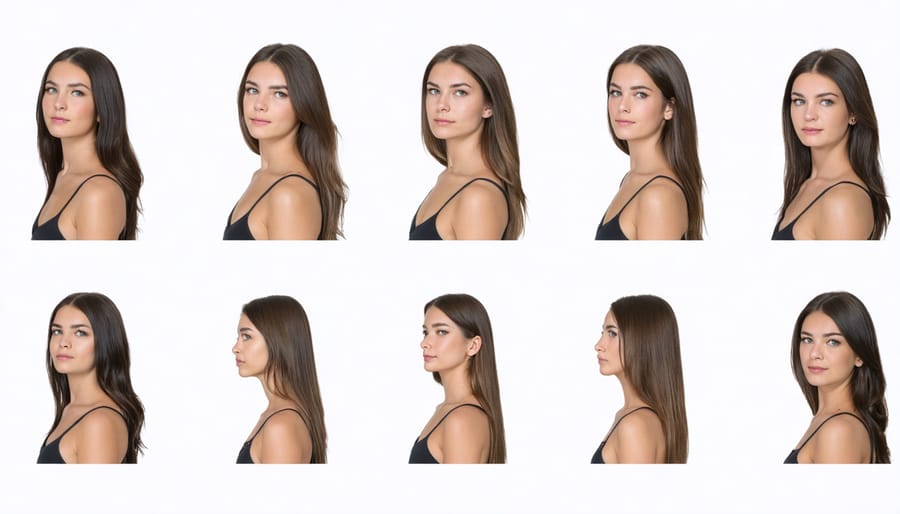
Telephoto (135mm+)
Telephoto lenses, particularly those at 135mm and beyond, create what many consider the most flattering portrait effects. These longer focal lengths compress facial features, reducing the apparent depth of the face and minimizing the prominence of features like the nose. This compression effect makes faces appear slimmer and more refined, which is why telephoto lenses are often favored by professional portrait photographers.
When shooting with a telephoto lens, you’ll need to position yourself farther from your subject – typically 10-15 feet away. This increased working distance has two benefits: it helps subjects feel more comfortable, as they’re not dealing with a camera right in their face, and it creates a beautifully blurred background with smooth bokeh that makes your subject pop.
However, these lenses do have practical considerations. You’ll need more space to work in, and indoor shoots may be challenging unless you have a large studio. They’re also more sensitive to camera shake, so using a faster shutter speed or a tripod is often necessary to ensure sharp images. Despite these challenges, the flattering perspective and professional results make telephoto lenses an invaluable tool for serious portrait photography.
Choosing the Right Focal Length for Your Portrait
Environmental Portraits
Environmental portraits tell a story by including the subject’s surroundings, and your choice of focal length plays a crucial role in how this story unfolds. While traditional portraits often favor longer focal lengths like 85mm or 105mm, environmental portraits can benefit from wider focal lengths between 35mm and 50mm.
These wider focal lengths allow you to capture both your subject and their meaningful environment without having to step too far back. A photographer shooting in a craftsman’s workshop, for instance, can include both the artisan and their tools while maintaining an intimate feeling. However, be mindful of subject placement when using wider focal lengths – keeping your subject near the center of the frame helps minimize distortion.
Medium focal lengths around 50mm offer a natural perspective that closely matches human vision, making them ideal for environmental portraits where authenticity is key. They provide enough width to include context while maintaining pleasing facial proportions.
For outdoor environmental portraits, longer focal lengths like 70mm can help compress the background, creating a pleasing relationship between your subject and distant elements like mountains or cityscapes. This compression effect can make backgrounds appear closer and more dramatic while still maintaining enough width to tell the environmental story.
Remember that the key to successful environmental portraits lies in finding the right balance between subject prominence and contextual elements, with your focal length choice serving as a vital tool in achieving this balance.
Headshots and Close-ups
When it comes to professional headshots and close-up portraits, focal length plays a crucial role in creating flattering results. The most widely recommended focal lengths for headshots fall between 85mm and 135mm on a full-frame camera. These longer focal lengths are preferred because they create natural-looking facial proportions while maintaining a comfortable working distance from your subject.
The 85mm focal length has become a classic choice for headshot photographers, offering an ideal balance between compression and practicality. At this focal length, facial features appear natural and well-proportioned, while the background compression creates beautiful, creamy bokeh that doesn’t distract from your subject.
Moving up to 105mm or 135mm provides even more compression, which can be particularly flattering for close-up portraits. These longer focal lengths tend to slim facial features slightly and minimize the appearance of any perspective distortion. They’re especially effective when shooting tight headshots where you want to emphasize your subject’s eyes and facial expressions.
Working distance is another important consideration. At 85mm, you’ll typically be positioned 6-8 feet from your subject, while a 135mm lens might require 10-12 feet. This distance helps subjects feel more comfortable and relaxed, resulting in more natural expressions. It also allows for better communication between photographer and subject without feeling intrusive.
Remember that these focal lengths can be adapted for crop-sensor cameras by calculating the equivalent field of view. For example, a 50mm lens on an APS-C camera provides a similar perspective to an 85mm on full-frame.
Common Mistakes to Avoid
When working with focal length in portrait photography, several common mistakes can significantly impact your results. One of the most frequent errors is shooting portraits with ultra-wide focal lengths (below 35mm), which can severely distort facial features and create an unflattering “bulbous” effect. This distortion is particularly noticeable in close-up shots, where noses appear larger and faces look unnaturally stretched.
Another prevalent mistake is standing too close to your subject while using a longer focal length. Even with an ideal portrait focal length of 85mm or 105mm, shooting too close can compress facial features uncomfortably. Always maintain appropriate working distances based on your chosen focal length – generally, the longer the focal length, the more space you’ll need between you and your subject.
Many photographers also fall into the trap of believing that one specific focal length is perfect for all portrait situations. While 85mm is often cited as the “ideal” portrait length, different scenarios may call for different focal lengths. For example, environmental portraits might benefit from a wider 35mm or 50mm to include context, while headshots might be better served by a 135mm lens.
Inconsistency in shooting height is another overlooked issue. Different focal lengths can affect how camera height impacts facial proportions. When shooting with wider angles, even slight variations in camera height can create unflattering perspectives, such as making the subject appear to have a larger forehead or chin.
To avoid these pitfalls, always test different focal lengths with your subject before committing to a specific setup. Pay attention to how each length affects their unique facial features, and don’t be afraid to adjust your position or switch lenses if something doesn’t look quite right. Remember that what works for one person’s face may not work for another’s, so avoid taking a one-size-fits-all approach to portrait focal lengths.
Understanding the effect of focal length on facial features is crucial for creating flattering and impactful portraits. As we’ve explored throughout this article, different focal lengths can dramatically alter how your subject appears in the final image, from the natural-looking perspective of 85-105mm to the potentially distorting effects of wide-angle lenses.
For most portrait photography situations, staying within the 85-105mm range will serve you well, as these focal lengths closely match human visual perception and produce the most natural-looking results. However, don’t be afraid to experiment with other focal lengths when the creative situation calls for it. A 35mm lens can help capture environmental portraits with context, while a 200mm lens can create beautiful compression effects for dramatic headshots.
Remember these key takeaways when choosing your focal length:
– Maintain appropriate shooting distance to avoid distortion
– Consider the story you want to tell with your portrait
– Match your focal length choice to your subject’s features and comfort
– Be mindful of the shooting environment and available space
– Practice with different focal lengths to understand their effects firsthand
The best approach is to start with the traditional portrait focal lengths and gradually experiment with alternatives as you develop your style. Keep your subject’s comfort and appearance as the primary consideration, and use your technical knowledge of focal length effects to enhance, rather than detract from, their natural features.
By mastering the relationship between focal length and facial features, you’ll be better equipped to make informed creative decisions and capture portraits that both you and your subjects will love.
